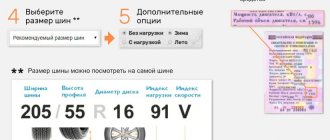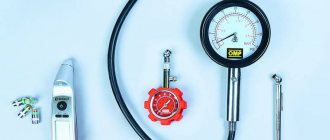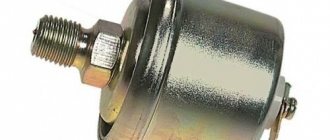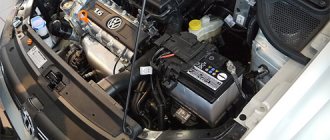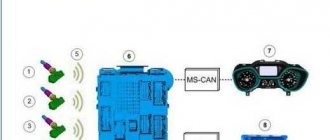Recommended tire pressure for Volkswagen Tiguan
Tire speed and load indices (indicated in the tables after the dimensions). The recommended tire pressure for your Volkswagen Tiguan is indicated in the owner's manual and also on a plate (on the gas filler flap, on the driver's door pillar or on the glove box lid).
IMPORTANT! The pressure must be measured on a cold tire (the car must be at rest for at least 2 hours before measurement).
IMPORTANT! All pressure values indicated in the table are given for the recommended tire sizes of your Volkswagen Tiguan.
Designations in the table : SSR - RUNFLAT tires, allowing you to continue driving after loss of air pressure in the tire; VA - standard size of tires installed on the front axle of the car; HA - standard size of tires installed on the rear axle of the car; XL is a tire with increased load capacity.
Volkswagen Tiguan 2007-2011
| Model and modification | Recommended tire size | Regular download | Full load | ||
| Front | Rear | Front | Rear | ||
| 1.4 TSI (110 kW) | 215/65 R 16 98 H 4x4 | 2.0 | 2.0 | 2.3 | 2.5 |
| 235/55 R 17 99 H 4x4 | 2.0 | 2.0 | 2.3 | 2.5 | |
| 235/50 R 18 97 H 4x4 | 2.0 | 2.0 | 2.3 | 2.5 | |
| 2.0 TSI (125 kW), 2.0 TDI (125 kW) | 215/65 R 16 98 V 4×4 | 2.2 | 2.2 | 2.5 | 2.7 |
| 235/55 R 17 99 V 4×4 | 2.2 | 2.2 | 2.5 | 2.7 | |
| 235/50 R 18 97 V 4×4 | 2.2 | 2.2 | 2.5 | 2.7 | |
| 2.0 TSI (147 kW) | 235/55 R 17 99 V 4×4 | 2.2 | 2.2 | 2.5 | 2.7 |
| 235/50 R 18 97 V 4×4 | 2.2 | 2.2 | 2.5 | 2.7 | |
| 2.0 TDI (103 kW) | 215/65 R 16 98 H 4x4 | 2.2 | 2.2 | 2.5 | 2.7 |
| 235/55 R 17 99 H 4x4 | 2.2 | 2.2 | 2.5 | 2.7 | |
| 235/50 R 18 97 H 4x4 | 2.2 | 2.2 | 2.5 | 2.7 | |
Volkswagen Tiguan 2011-...
| Model and modification | Recommended tire size | Regular download | Full load | ||
| Front | Rear | Front | Rear | ||
| 1.4 TSI (90 kW), 2.0 TDI (81 kW), 2.0 TDI (103 kW) | 215/65 R 16 98 H 4x4 | 2.2 | 2.2 | 2.5 | 2.7 |
| 235/55 R 17 99 H 4x4 | 2.2 | 2.2 | 2.5 | 2.7 | |
| 235/50 R 18 97 H 4x4 | 2.2 | 2.2 | 2.5 | 2.7 | |
| 255/40 R 19 96 H 4x4 | 2.2 | 2.2 | 2.5 | 2.7 | |
| 1.4 TSI (118 kW), 2.0 TSI (132 kW) | 215/65 R 16 98 V 4×4 | 2.2 | 2.2 | 2.5 | 2.7 |
| 235/55 R 17 99 V 4×4 | 2.2 | 2.2 | 2.5 | 2.7 | |
| 235/50 R 18 97 V 4×4 | 2.2 | 2.2 | 2.5 | 2.7 | |
| 255/40 R 19 96 V 4×4 | 2.2 | 2.2 | 2.5 | 2.7 | |
| 2.0 TSI (155 kW), 2.0 TDI (125 kW) | 235/55 R 17 99 V 4×4 | 2.2 | 2.2 | 2.5 | 2.7 |
| 235/50 R 18 97 V 4×4 | 2.2 | 2.2 | 2.5 | 2.7 | |
| 255/40 R 19 96 V 4×4 | 2.2 | 2.2 | 2.5 | 2.7 | |
wikers.ru
Volkswagen Tiguan tire sizes and pressures
Compactness, sportiness, comfort - these three words are mainly used when describing the Volkswagen Tiguan car. The crossover has been produced for more than ten years. During this time it was changed, but the main features remained the same.
Volkswagen Tiguan is reliable. It can serve for many years without breakdowns or other troubles. The main thing is to provide it with proper care, to monitor each of its details separately.
Some drivers forget that the key to good and safe driving is not only the engine, but also the wheels. At first glance, these are insignificant spare parts in a vehicle, but in fact they are fundamental. Not only a leaky wheel will cause trouble, but also low or high tire pressure. The vehicle's handling and road stability will immediately deteriorate, which is extremely life-threatening. To prevent this, it is necessary to constantly monitor the condition of the tires. Check their pressure at least once a week. What it should be is indicated in the table.
Volkswagen Tiguan tire dimensions and inflation pressure
| Engine | Tire size | Partial loading | Full load | ||
| Front, bar | Rear, bar | Front, bar | Rear, bar | ||
| 1.4TSI | 215/65 R16 235/55 R17 235/50 R18 | 2,0 | 2,0 | 2,3 | 2,5 |
| 2.0 TSI 2.0 TDI | 215/65 R16 235/55 R17 235/50 R18 | 2,2 | 2,2 | 2,5 | 2,7 |
Load capacity index - 99M
Wheel nut tightening torque:
Cars with front-wheel drive - 140 Nm. Cars with all-wheel drive - 120 Nm.
In winter, tire pressure decreases by 7 kPa (1 psi) for every 7 °C (12 °F) drop in temperature.
polomkiauto.ru
Tire pressure Volkswagen Polo, Tiguan, Passat
Young car enthusiasts are often interested in what pressure should be in the tires of a car and what are the consequences of deviating from it? Failure to comply with tire pressure standards can contribute to premature failure of machine components, increased tire wear, and other more serious consequences.
Consequences of non-compliance with tire pressure
Low pressure contributes to tire deformation, increased heating when driving, and premature tread wear. In some cases - to the destruction of the frame. When the pressure is below normal, fuel consumption increases. If you focus on domestic roads, then if your wheel hits a pothole, there is a high risk of damaging not only the tire, but also the rim.
Tire damage
High pressure leads to increased load on the cord, which accelerates tread wear. In addition, when driving on a road surface with potholes, the shocks transmitted to the suspension and body will be more noticeable for the driver and passengers. If you fall into a hole, there is a high probability of a tire rupture.
IMPORTANT! A serious danger is represented by different pressures in all wheels of a car. This is the most dangerous case! When driving, the car will inevitably be “pulled” towards the wheel with the lowest pressure. The car will actually start moving sideways.
Frequency of pressure checks
Previously, tube tires required periodic pressure checks - once a week. With the advent of butyl rubber tubes, there was no need for frequent inspection. The use of modern technologies allows us to limit ourselves to an external inspection.
Tire pressure measurement
Ideally, it is necessary to check the tire pressure at least once every 30 days, and before a long trip it is mandatory!
Tire pressure Volkswagen Polo
To answer the question of what pressure should be in the tires of a Volkswagen Polo, you need to read the vehicle’s technical operation manual - the pressure must correspond to that specified by the car manufacturer.
The manufacturers of the Volkswagen Polo have made a “cheat sheet” for drivers on the gas tank hatch. An elementary way to find out the pressure is to open the tank hatch.
However, there is a category of drivers who do not agree with the manufacturer and are ready to challenge his recommendations. According to the table, the pressure in the tires of a Volkswagen Polo when fully loaded on the rear axle should be 2.6 atm. This rule applies to tires with diameters R14 and R15.
Pressure parameters in Volkswagen Polo
The reason where these pressure values come from lies in the testing of cars for all characteristics, including tire pressure, before releasing the car into series. A fully loaded car means that it contains almost 600 kg – that’s 5 people, including the driver, and about 100 kg of cargo. The technical instruction manual states that the maximum load of the Volkswagen Polo sedan is 576 kg.
If you often transport cargo or 3–4 passengers, then the normal tire pressure in your Volkswagen is 2.4 atm. — on the front axle, 2.6 atm. – on the rear. The value indicated in column 1 of the table is -2 atm. - front and 1.8 atm. - rear, applicable only when only the driver drives and does not transport other people or cargo.
What could be the pitfalls - changes in pressure standards determined by Volkswagen. In frosty weather, the pressure in the wheels decreases, sometimes by up to 0.5 atm. In winter, tire pressure should be checked more often.
IMPORTANT! A low tire at sub-zero temperatures has better grip on the road surface and the braking distance is reduced by about 5%. But at the same time, an under-inflated tire wears out 30% more than an inflated tire according to the standard recommended by Volkswagen.
Volkswagen Polo
The choice is up to the car owner, but the grip of a wheel with pressure below normal is much worse, and the chances of flying off the road into a ditch with lowered wheels are much higher. It is considered reasonable to reduce tire pressure in winter within 10% of the maximum value. Otherwise, when loading the car in one trip, you can lose half the studs from the tires.
Tire pressure Volkswagen Tiguan
Are tire pressures the same or different for all Volkswagen models? What is the tire pressure of a Volkswagen Tiguan?
The Volkswagen Tiguan is highly reliable. It can serve for many years without breakdowns, but this is only if the car is properly cared for. A certain category of car owners forget that wheels are one of the components of safe driving. Not only a flat tire, but also inappropriate tire pressure can cause trouble for the driver.
Volkswagen Tiguan
As on other Volkswagen models, the manufacturer's recommended tire pressure for the Volkswagen Tiguan is indicated on the gas tank flap.
The advantage of the Tiguan model compared to its analogues is the presence of a tire pressure monitoring system. This system is designed to transmit information to the driver about the pressure in each of the wheels. Information is displayed on the dashboard. The operating principle of the system is based on the presence of sensors and transmitters in each of the wheels.
When driving, tire pressure sensors in the Volkswagen Tiguan provide information about the pressure of each wheel. The automation located in each of the sensors instantly detects a decrease in tire pressure. Using installed sensors, the system recognizes a decrease in the radius of one of the wheels, which is perceived by the sensor as a decrease in pressure in one of the wheels. The corresponding command is indicated by the warning light on the instrument panel coming on.
The table on the Volkswagen Tiguan tank cap indicates the pressure:
— front and rear – 2.2 atm.;
- full load - 2.5 atm. – front, 2.7 atm. - butt
Tire pressure Volkswagen Passat
The Volkswagen Passat, like the Tiguan, is equipped with Volkswagen tire pressure sensors. The optimal tire pressure for the Passat is indicated in the table located on the back of the gas tank hatch. However, the optimal pressure provided in the table applies to the tires installed by the manufacturer. As a rule, the manufacturer installs wheels with a diameter of R16 or R17 on Volkswagen Passat.
According to the table, it is recommended to maintain a pressure of 1.9 atm. - on both axes. At maximum load, you can increase the pressure:
- in front - 2.2 atm.;
- rear – 2.7 atm.
If the Passat has tires of a different size, for example R15, then you need to pump the wheels based on the advice of the tire manufacturer. Manufacturers of high-quality tires usually indicate all the necessary characteristics on the side of the tire (pressure, size, speed index, etc.), and the information of interest can be obtained from the tire seller. Sensors will control the level of pressure in the tires after they are installed.
IMPORTANT! Regarding the tire pressure of the Passat, as well as any other car, it is worth considering a number of features. For a long trip on a flat surface, it is better to slightly increase the pressure to the maximum possible value, and when driving on “dirt” and sand, lower it to the permissible maximum. Regarding the Passat - further work of the pressure sensor!
Tire pressure Volkswagen Jetta and Transporter
The Volkswagen Jetta, regardless of whether it is a sedan or a hatchback, requires tire pressure monitoring. Each driver has the right to set the level of wheel inflation himself.
However, the recommended pressure settings on the gas cap are as follows:
- for an unloaded car - 2.2 atm. - on both axes;
- for full load – 2.6 atm. – front, 2.8 atm. - rear axle.
According to Jetta car owners, if the tire pressure is less than normal, then the car's ride is softer, but fuel consumption increases, and if it is more, then vice versa.
Based on the “cheat sheets” on the gas tank caps of the Transporter, the pressure values on them may differ depending on whether it is a cargo or passenger version. Also, the tabular data concerns the tires installed on the car by the manufacturer.
So for an unloaded car using different wheel diameters:
- front - 2.2 - 3.5 atm.;
- rear – 2.5 – 3.5 atm.
IMPORTANT! It is necessary to check the pressure on cold tires, since after a trip they heat up and, accordingly, the pressure increases. The pressure is checked at least once a month, as well as during maintenance. In addition to the sticker on the car, the recommended pressure is indicated in the Operating Manual. You should also check your tire pressure before driving for long periods of time.
kolesnyigid.ru
Studded winter tires for Volkswagen Tiguan
Studded tires are the traditional choice of domestic car enthusiasts for driving on clear ice and hard snow crust. Most often, Tiguan owners choose studded tires from the following manufacturers:
- Goodyear Ultra Grip Ice Arctic is a model from an American manufacturer, aimed at use in Canada, Scandinavian countries and Russia. Directional studs and interlocking blocks, combined with a traditional V-shaped tread pattern, provide effective starting and braking on icy surfaces.
- Yokohama Ice Guard IG65 is a Japanese tire, highly appreciated by domestic car owners. A wide longitudinal rib in the central part and stepped lamellas enhance traction and prevent lateral sliding.
- Nokian Hakkapeliitta 8 is a Finnish development with a symmetrical directional tread and anchor-type studs. It has high traction and directional stability characteristics with low noise levels.
Sources:
- wikers.ru
- kolesospec.ru
- polomkiauto.ru
- zapchasti.expert
What pressure should be in the tires of Volkswagen cars?
| Volkswagen Up | 2011-2014 | 175/65 R14 | 2,0/29 | 1,8/26 |
| Volkswagen Up | 2011-2014 | 185/55 R15 | 2,0/29 | 2,5/36 |
| Volkswagen Lupo | 1998-2005 | 155/70 R13 | 2,1/30 | 2,0/29 |
| Volkswagen Lupo | 1998-2005 | 175/65 R13 | 2,1/30 | 2,0/28 |
| Volkswagen Lupo 1.4/Diesel | 1998-2005 | 175/65 R13 | 2,0/29 | 1,9/27 |
| Volkswagen Lupo 1.4/Diesel | 1998-2005 | 185/55 R14 | 2,2/31 | 2,0/29 |
| Volkswagen Fox 1.2 PAS | 2006-2012 | 185/60 R14 | 2,0/29 | 2,0/28 |
| Volkswagen Fox 1.2 PAS | 2006-2012 | 195/55 R15 | 2,0/28 | 2,0/28 |
| Volkswagen Fox 1.4/1.4TDI | 2006-2012 | 165/70 R14 | 2,1/30 | 2,0/29 |
| Volkswagen Fox 1.4/1.4TDI | 2006-2012 | 185/60 R14 | 2,2/31 | 2,0/29 |
Volkswagen Polo | 1994-2002 | 155/70 R13 | 2,1/30 | 2,1/30 |
| Volkswagen Polo 1.0 | 1994-2002 | 175/65 R13 | 1,9/27 | 1,9/27 |
| Volkswagen Polo 1.4 | 1994-2002 | 175/65 R13 | 2,0/29 | 1,9/27 |
| Volkswagen Polo 1.4 | 1994-2002 | 185/55 R14 | 2,2/31 | 2,0/29 |
| Volkswagen Polo 1.4 | 1994-2002 | 195/45 R15 | 2,2/31 | 2,0/29 |
| Volkswagen Polo 1.4/1.6/1.7D/1.9D | 1994-2002 | 175/65 R13 | 2,1/30 | 1,9/27 |
| Volkswagen Polo 1.4/1.6/1.7D/1.9D | 1994-2002 | 185/55 R14 | 2,3/33 | 2,1/30 |
| Volkswagen Polo 1.4/1.6/1.7D/1.9D | 1994-2002 | 195/45 R15 | 2,3/33 | 2,1/30 |
| Volkswagen Polo 1.4 16V | 1994-2002 | 185/55 R14 | 2,3/33 | 2,1/30 |
| Volkswagen Polo 1.4 16V | 1994-2002 | 195/45 R15 | 2,3/33 | 2,1/30 |
| Volkswagen Polo 1.6 16V | 1994-2002 | 185/55 R14 | 2,7/38 | 2,5/35 |
| Volkswagen Polo 1.6 16V | 1994-2002 | 195/45 R15 | 2,7/38 | 2,5/35 |
| Volkswagen Polo 1.4D | 1994-2002 | 175/65 R13 | 2,2/31 | 2,0/29 |
| Volkswagen Polo 1.4D | 1994-2002 | 185/55 R14 | 2,5/35 | 2,2/31 |
| Volkswagen Polo 1.4D | 1994-2002 | 195/45 R15 | 2,5/35 | 2,2/31 |
| Volkswagen Polo Classic 1.4/1.6/1.8 | 1994-2002 | 185/60 R14 | 2,2/31 | 2,2/31 |
| Volkswagen Polo Classic 1.4/1.6/1.8 | 1994-2002 | 185/55 R15 | 2,2/31 | 2,1/30 |
| Volkswagen Polo Classic 1.7D/1.9D | 1994-2002 | 185/60 R14 | 2,1/30 | 2,0/29 |
| Volkswagen Polo Classic 1.7D/1.9D | 1994-2002 | 185/55 R15 | 2,1/30 | 2,0/29 |
| Volkswagen Polo Classic 1.9TD | 1994-2002 | 185/60 R14 | 2,3/33 | 2,2/31 |
| Volkswagen Polo Classic 1.9TD | 1994-2002 | 185/55 R15 | 2,0/29 | 1,9/27 |
| Volkswagen Polo 1.2 | 2002-2009 | 155/80 R13 | 2,3/33 | 2,1/30 |
| Volkswagen Polo 1.2 | 2002-2009 | 165/70 R14 | 2,0/29 | 1,9/27 |
| Volkswagen Polo 1.2 PAS | 2002-2009 | 155/80 R13 | 2,0/29 | 1,9/27 |
| Volkswagen Polo 1.4 | 2002-2009 | 165/70 R13 | 2,2/31 | 2,0/29 |
| Volkswagen Polo 1.4 | 2002-2009 | 185/60 R14 | 2,1/30 | 2,0/29 |
| Volkswagen Polo 1.4 | 2002-2009 | 195/55 R15 | 1,9/27 | 1,9/27 |
| Volkswagen Polo 1.4 | 2002-2009 | 205/45 R16 | 2,2/31 | 2,1/30 |
| Volkswagen Polo 1.4 TDI | 2002-2009 | 165/70 R14 | 2,3/33 | 2,1/30 |
| Volkswagen Polo 1.4 TDI | 2002-2009 | 185/60 R14 | 2,3/33 | 2,1/30 |
| Volkswagen Polo 1.4 TDI | 2002-2009 | 195/55 R15 | 2,0/29 | 1,9/27 |
| Volkswagen Polo 1.4 TDI | 2002-2009 | 205/45 R16 | 2,3/33 | 2,1/30 |
| Volkswagen Polo 1.9 TDI | 2002-2009 | 165/70 R14 | 2,2/31 | 2,0/29 |
| Volkswagen Polo 1.9 TDI | 2002-2009 | 185/60 R14 | 2,2/31 | 2,0/29 |
| Volkswagen Polo 1.2 | 2009-2014 | 175/70 R14 | 1,9/27 | 1,9/27 |
| Volkswagen Polo 1.2 | 2009-2014 | 185/60 R15 | 1,9/27 | 1,9/27 |
| Volkswagen Polo 1.4I/1.6TDI | 2009-2014 | 185/60 R15 | 2,2/31 | 2,2/31 |
| Volkswagen Polo 1.4I/1.6TDI | 2009-2014 | 195/55 R15 | 2,2/31 | 2,2/31 |
Volkswagen Golf/Bora | 1997-2003 | 175/80 R14 | 1,9/27 | 1,9/27 |
| Volkswagen Golf/Bora | 1997-2003 | 195/65 R15 | 2,0/29 | 2,0/29 |
| Volkswagen Golf/Bora 2.3 V R5 | 1997-2003 | 195/65 R15 | 2,1/30 | 1,9/27 |
| Volkswagen Golf/Bora 2.3 V R5 | 1997-2003 | 225/45 R17 | 2,3/33 | 2,1/30 |
| Volkswagen Golf/Bora 2.8 V R6 | 1997-2003 | 205/60 R15 | 2,3/33 | 2,1/30 |
| Volkswagen Golf/Bora 2.8 V R6 | 1997-2003 | 225/45 R14 | 2,3/33 | 2,1/30 |
| Volkswagen Golf/Bora | 1997-2003 | 205/55 R16 | 2,3/33 | 2,1/30 |
| Volkswagen Golf | 2003-2009 | 195/65 R15 | 2,5/35 | 2,2/32 |
| Volkswagen Golf | 2003-2009 | 205/55 R16 | 2,5/35 | 2,2/32 |
| Volkswagen Golf | 2003-2009 | 225/45 R17 | 2,5/35 | 2,2/32 |
| Volkswagen Golf | 2008-2013 | 195/65 R15 | 2,0/29 | 2,0/29 |
| Volkswagen Golf | 2008-2013 | 205/60 R15 | 2,0/29 | 2,0/29 |
| Volkswagen Golf | 2008-2013 | 205/55 R16 | 2,3/33 | 2,3/33 |
| Volkswagen Golf | 2008-2013 | 225/45 R17 | 2,3/33 | 2,3/33 |
| Volkswagen Golf 2.0TDI | 2008-2013 | 195/65 R15 | 2,3/33 | 2,3/33 |
| Volkswagen Golf 1.4 TSI2.0TDI | 2008-2013 | 205/60 R15 | 2,3/33 | 2,3/33 |
| Volkswagen Golf Plus | 2009-2014 | 195/65 R15 | 2,2/31 | 2,2/31 |
| Volkswagen Golf Plus | 2009-2014 | 205/60 R15 | 2,2/31 | 2,2/31 |
| Volkswagen Golf Plus | 2009-2014 | 205/55 R16 | 2,2/31 | 2,2/31 |
| Volkswagen Golf Plus | 2009-2014 | 225/45 R17 | 2,2/31 | 2,2/31 |
| Volkswagen Golf 1.6 Bluemotion | 2009-2014 | 195/65 R15 | 2,5/36 | 2,5/36 |
| Volkswagen Golf 1.6 Bluemotion | 2009-2014 | 225/45 R17 | 2,5/36 | 2,5/36 |
| Volkswagen Golf 2.0TDI | 2009-2014 | 195/65 R15 | 2,3/33 | 2,3/33 |
| Volkswagen Golf 2.0TDI | 2009-2014 | 205/60 R15 | 2,3/33 | 2,3/33 |
| Volkswagen Golf Estate 1.4/1.6 | 2007-2014 | 195/65 R15 | 2,0/29 | 2,0/29 |
| Volkswagen Golf Estate 1.4/1.6 | 2007-2014 | 205/55 R16 | 2,0/29 | 2,0/29 |
| Volkswagen Golf Estate 1.9/2.0TDI | 2007-2014 | 195/65 R15 | 2,0/29 | 2,0/29 |
| Volkswagen Golf Estate 1.9/2.0TDI | 2007-2014 | 205/55 R16 | 2,0/29 | 2,0/29 |
| Volkswagen Golf Estate 2.0TDI 125KW | 2007-2014 | 225/45 R17 | 2,4/34 | 2,4/34 |
| Volkswagen Golf Estate 2.0TDI 125KW | 2007-2014 | 225/40 R18 | 2,4/34 | 2,4/34 |
Volkswagen Jetta | 2005-2011 | 225/45 R17 | 2,1/30 | 2,1/30 |
| Volkswagen Jetta 2.0TDI | 2005-2011 | 225/45 R17 | 2,4/34 | 2,4/34 |
| Volkswagen Jetta 2.0TDI | 2005-2011 | 225/40 R18 | 2,4/34 | 2,4/34 |
Volkswagen Beetle | 1999-2011 | 195/65 R15 | 2,1/30 | 2,0/29 |
| Volkswagen Beetle | 1999-2011 | 205/55 R16 | 2,2/31 | 2,0/29 |
| Volkswagen Beetle | 1999-2011 | 205/65 R16 | 2,3/33 | 2,1/30 |
Volkswagen Passat | 1996-2005 | 195/65 R15 | 2,1/30 | 2,1/30 |
| Volkswagen Passat | 1996-2005 | 205/60 R15 | 2,1/30 | 2,1/30 |
| Volkswagen Passat 2.8/2.5TDI | 1996-2005 | 195/65 R15 | 2,6/37 | 2,4/34 |
| Volkswagen Passat 2.8/2.5TDI | 1996-2005 | 205/60 R15 | 2,6/37 | 2,4/34 |
| Volkswagen Passat 1.8 | 2005-2011 | 205/55 R16 | 2,3/33 | 2,3/33 |
| Volkswagen Passat 1.8 | 2005-2011 | 205/50 R17 | 2,3/33 | 2,3/33 |
| Volkswagen Passat 1.9TDI | 2005-2011 | 205/55 R16 | 2,0/29 | 2,1/30 |
| Volkswagen Passat 1.9TDI | 2005-2011 | 215/55 R16 | 2,1/30 | 2,1/30 |
| Volkswagen Passat 20/2.0TDI | 2005-2011 | 205/55 R16 | 2,3/33 | 2,3/33 |
| Volkswagen Passat 20/2.0TDI | 2005-2011 | 205/50 R17 | 2,3/33 | 2,3/33 |
| Volkswagen Passat 2.0TDI Bluemotion | 2005-2011 | 235/45 R17 | 2,5/36 | 2,5/36 |
| Volkswagen Passat 2.0TDI Bluemotion | 2005-2011 | 235/40 R18 | 2,7/38 | 2,7/38 |
| Volkswagen Passat CC | 2008-2012 | 205/50 R17 | 2,3/33 | 2,3/33 |
| Volkswagen Passat CC | 2008-2012 | 235/45 R17 | 2,3/33 | 2,3/33 |
| Volkswagen Passat 2.0 TSI/2.0TDI | 2008-2012 | 235/45 R17 | 2,4/34 | 2,4/34 |
| Volkswagen Passat 2.0 TSI/2.0TDI | 2008-2012 | 235/40 R18 | 2,4/34 | 2,4/34 |
| Volkswagen Passat 3.6FSI | 2008-2012 | 205/50 R17 | 2,7/38 | 2,7/38 |
| Volkswagen Passat 3.6FSI | 2008-2012 | 235/35 R19 | 3,0/42 | 3,0/42 |
Volkswagen Phaeton | 2003-2014 | 235/60 R16 | 2,1/30 | 1,9/27 |
| Volkswagen Phaeton | 2003-2014 | 235/60 R16 | 2,1/30 | 1,9/27 |
| Volkswagen Phaeton | 2003-2014 | 235/50 R18 | 2,3/33 | 2,1/30 |
| Volkswagen Phaeton | 2003-2014 | 255/45 R18 | 2,6/37 | 2,4/34 |
| Volkswagen Eos | 2006-2014 | 205/55 R16 | 2,2/32 | 2,2/32 |
| Volkswagen Eos | 2006-2014 | 235/45 R17 | 2,2/32 | 2,2/32 |
| Volkswagen Eos 3.2I | 2006-2014 | 205/55 R16 | 2,6/37 | 2,6/37 |
| Volkswagen Eos 3.2I | 2006-2014 | 235/45 R17 | 2,6/37 | 2,6/37 |
Volkswagen Touran | 2003-2010 | 195/65 R15 | 2,5/35 | 2,5/35 |
| Volkswagen Touran | 2003-2010 | 205/55 R16 | 2,5/35 | 2,5/35 |
| Volkswagen Touran | 2003-2010 | 225/40 R18 | 2,5/35 | 2,5/35 |
| Volkswagen Touran Bluemotion | 2003-2010 | 205/55 R16 | 2,6/37 | 2,6/37 |
| Volkswagen Touran Bluemotion | 2003-2010 | 215/50 R17 | 2,6/37 | 2,6/37 |
Volkswagen Scirocco | 2008-2014 | 205/55 R16 | 2,1/30 | 2,1/30 |
| Volkswagen Scirocco 1.4 | 2008-2014 | 225/45 R17 | 2,1/30 | 2,1/30 |
| Volkswagen Scirocco Bluemotion | 2008-2014 | 205/55 R16 | 2,4/34 | 2,4/34 |
| Volkswagen Scirocco Bluemotion | 2008-2014 | 225/45 R17 | 2,4/34 | 2,4/34 |
| Volkswagen Scirocco 2.0TSI | 2008-2014 | 225/45 R17 | 2,5/36 | 2,5/36 |
| Volkswagen Scirocco 2.0TSI | 2008-2014 | 235/45 R17 | 2,3/33 | 2,3/33 |
| Volkswagen Sharan | 2001-2010 | 195/65 R15 | 2,6/37 | 2,4/34 |
| Volkswagen Sharan | 2001-2010 | 195/65 R16 | 2,8/40 | 2,7/38 |
| Volkswagen Sharan | 2001-2010 | 205/60 R15 | 2,7/38 | 2,5/36 |
| Volkswagen Sharan | 2001-2010 | 215/60 R15 | 2,3/33 | 2,2/31 |
| Volkswagen Sharan | 2001-2010 | 215/55 R16 | 2,7/39 | 2,6/37 |
| Volkswagen Sharan | 2001-2010 | 225/45 R17 | 3,0/42 | 3,0/42 |
| Volkswagen Sharan 2.0TDI 125KW | 2010-2013 | 215/55 R16 | 2,4/34 | 2,4/34 |
| Volkswagen Sharan 2.0TDI 125KW | 2010-2013 | 225/50 R17 | 2,4/34 | 2,4/34 |
Volkswagen Tiguan | 2007-2014 | 215/65 R16 | 2,0/29 | 2,0/29 |
| Volkswagen Tiguan | 2007-2014 | 235/55 R18 | 2,0/29 | 2,0/29 |
| Volkswagen Tiguan 2.0/2.0TDI | 2007-2014 | 215/65 R16 | 2,2/32 | 2,2/32 |
| Volkswagen Tiguan 2.0/2.0TDI | 2007-2014 | 235/55 R18 | 2,2/32 | 2,2/32 |
Volkswagen Toureg | 2003-2010 | 235/70 R16 | 2,4/34 | 2,5/36 |
| Volkswagen Toureg | 2003-2010 | 255/60 R17 | 2,5/36 | 2,6/37 |
| Volkswagen Toureg | 2003-2010 | 235/60 R18 | 2,5/36 | 2,6/37 |
| Volkswagen Toureg | 2003-2010 | 275/40 R20 | 2,7/39 | 3,1/44 |
| Volkswagen Toureg | 2010-2014 | 235/65 R17 | 2,3/33 | 2,5/36 |
| Volkswagen Toureg | 2010-2014 | 255/60 R17 | 2,3/33 | 2,5/36 |
| Volkswagen Toureg | 2010-2014 | 255/55 R18 | 2,3/33 | 2,5/36 |
Volkswagen Amarok | 2010-2014 | 245/65 R17 | 2,1/30 | 2,1/30 |
| Volkswagen Caddy | 1994-2004 | 175/65 R14 | 2,2/31 | 2,5/35 |
| Volkswagen Caddy | 1994-2004 | 185/60 R14 | 2,2/31 | 2,5/35 |
| Volkswagen Caddy | 2004-2011 | 195/65 R15 | 2,1/30 | 2,5/36 |
| Volkswagen Caddy | 2004-2014 | 205/55 R16 | 2,1/30 | 2,5/36 |
| Volkswagen Transporter | 1996-2003 | 195/70 R15 | 3,9/55 | 4,0/57 |
| Volkswagen Transporter | 1996-2003 | 205/65 R15 | 3,5/50 | 3,2/46 |
| Volkswagen Caravelle/Multivan | 1996-2003 | 195/70 R15 | 2,6/37 | 2,4/34 |
| Volkswagen Caravelle/Multivan | 1996-2003 | 205/65 R16 | 2,7/39 | 2,5/36 |
Volkswagen Transporter | 2003-2014 | 205/65 R16 | 4,0/57 | 3,6/51 |
| Volkswagen Transporter | 2003-2014 | 215/65 R15 | 3,4/48 | 3,4/48 |
| Volkswagen Transporter | 2003-2014 | 235/60 R16 | 2,9/41 | 2,9/41 |
| Volkswagen Transporter | 2003-2014 | 215/65 R17 | 3,6/51 | 3,6/51 |
| Volkswagen Transporter | 2003-2014 | 215/60 R17 | 3,9/55 | 3,9/55 |
| Volkswagen Transporter | 2003-2014 | 235/55 R17 | 3,1/44 | 2,7/38 |
howcarworks.ru
Tire Pressure - General Operation Issues
What happens when tire pressure is too low?
It should be said right away that “lowering” the tire pressure by more than 15% is absolutely pointless and dangerous - this will no longer bring any additional benefits, and safety will suffer significantly, so let’s look at the pros and cons of lowering the tire pressure exactly within the limits 5-15% (from the norm specified by the car manufacturer).
So, when the tire pressure decreases, something like this happens:
1. The contact patch of the tire with the road surface increases, and it increases due to the area of the tire that is not intended for contact with the road at all (side surfaces). But this is the case if the pressure is significantly lower than normal. If you reduce the pressure by only 10-15% and the tread is not very worn, the distribution of the load on the tread will simply change, and it will wear unevenly, i.e. The tread will wear faster at the edges. At the same time, the off-road patency of the tire increases due to the reduction in the specific weight of the vehicle, which falls on a unit area of the spot. Another consequence associated with an increase in the area of the contact patch is an increase in fuel consumption (however, if we are talking about the indicated 5-15% decrease in pressure, you are unlikely to feel any difference in fuel consumption).
2. The wheel becomes “softer”. Due to lower pressure, elasticity is reduced and the tire “absorbs” road unevenness to a greater extent, transferring much less load to key suspension components - levers, ball joints, tie rod ends and shock absorber support bearings. At the same time, the ride over bumps becomes much more comfortable, and the braking distance on uneven road surfaces is reduced. There is also a negative consequence - controllability and road stability suffer. But, if you are not a fan of “squeezing” out of the car everything it is capable of, you will not feel these changes.
Thus, by deliberately lowering the tire pressure, say, by 5%, 10% or 15% of that recommended by the car manufacturer in bad road conditions, you gain increased comfort, extend the life of the car suspension and slightly increase braking efficiency on poor road surfaces, but at In this case, the tires wear out faster, you need to drive more carefully and fuel consumption will increase slightly. Whether to do so or not is up to you.
Let me clarify once again: this article is not a recommendation for action, because, as stated at the beginning, only the pressure calculated by the car manufacturer is correct and safe. Therefore, everything you read above should be considered solely as a personal opinion. Remember that in any case, all responsibility for any consequences of your decision about what pressure to pump in your tires rests only with you and no one else.
www.tiguan-club.org
Tire pressure in a Volkswagen Jetta
For such cars, the most optimal Bar indicators are 2.2 atmospheres on all four tires. When the vehicle load increases, the front tires will need to be inflated to 2.6, and the rear tires to 2.8 bar. By the way, the full load of such a car should be no more than 600 kilograms.
Some car owners deliberately reduce tire pressure, as this helps the car run smoothly.
But there is also a negative side to this comfort - fuel consumption increases noticeably. If, on the contrary, you overinflate the tires, then less fuel will be consumed, but driving comfort will completely disappear. The driver and his passengers will literally feel every bump and pothole on the road.
Premature tire wear
Therefore, it is best to keep the golden mean of pressure indicators: fuel consumption will be normal and the comfort of movement will be quite acceptable. It’s not for nothing that the car manufacturer indicates such parameters on the gas tank flap. After all, before it gets to car dealerships, the car goes through a bunch of tests, as a result of which the optimal tire pressure on the front and rear axles is calculated. And if you do not follow these recommendations, then some car parts may become unusable and will have to be replaced.
Owners of Volkswagen cars often cannot inflate their tires to the correct levels, because they simply do not know what they should be. You need to remember that every car has manufacturer's recommendations in the form of a hint that you just need to look for on your car. That’s the whole secret of optimal pressure in Volkswagen tires.
Tiguan tires: size, pressure sensor
One of the popular crossovers from the legendary manufacturer is the Volkswagen Tiguan. The car began production in 2007, and over its short history has become one of the best crossovers in the world. Volkswagen Tiguan has 2 generations and one version of the first generation restyling. As with any car, the Tiguan needs to change wheels depending on the season, and to do this correctly, you need to know the Tiguan tire size and a number of other parameters that will help you make the perfect choice.
Tiguan
Dimension
To properly replace wheels, you must first select the tire size for the car. What are the wheel sizes for Volkswagen Tiguan?
The size of the standard tires is (for example, Tiguan 2018, with a 2.0l engine):
- 215/65 R17;
- 235/55 R18;
- 255/45R
Important: size 235/55 is present in all generations of the machine, and fits almost all modifications, but do not forget that each configuration has its own size, which is recommended to be observed!
In addition to the factory dimensions, there are several other standard sizes that are acceptable for installation (using the example of a 2nd generation Tiguan, with a 2.0 engine):
- 235/50R19;
- 235/45R20;
- 255/40R20.
Such standard sizes are acceptable for installation without loss of vehicle performance.
Attention: when installing tires of non-recommended sizes, you must consult a specialist or an authorized dealer! Installing non-standard elements in a car can lead to loss of warranty, and in some cases, to vehicle breakdown!
Pressure
One of the most important parameters responsible for the smoothness and controllability of a car is pressure. By observing the recommended indicators, you can achieve “softness” in the suspension, and the car will fully reveal all its driving characteristics.
It is recommended to set the tire pressure for Volkswagen Tiguan at 2.3 atm. for the front wheels and 2.5 atm. for the rear (without load). For cars with a “full load” it is recommended to set the value to 2.5 atm. for front and 2.7 atm. for the rear wheels.
Tire pressure setting
The recommended Tiguan tire pressure can be found on the gas cap or in the vehicle's owner's manual.
All modern cars have a pressure control system, and the Tiguan is no exception. There are 2 types of equipment:
- Special sensors are not installed - the system works through ABS, reading information due to the difference in angular speeds, and if the pressure readings change, the driver is informed about this through the corresponding indicator on the dashboard. When installing new tires or changing pressure, it is necessary to calibrate the system to the new values. This is done by pressing a special button or through the “Tires” section in the on-board computer.
- For monitoring, Tiguan tire pressure sensors are installed, which display complete information about the condition of the wheel on the display. The downside of the system is its unreliability and the need to install sensors on each set of wheels. Another disadvantage is the possibility of errors in the operation of the sensors during severe frosts or other factors affecting tire pressure.
Attention: when buying a new car, sometimes you need to adjust the pressure to the required levels yourself! This is explained by the fact that when they come off the assembly line, the tires are inflated more strongly (for transportation), and not every car dealership “equalizes” the pressure to the required levels.
Replacement
In order to choose the ideal replacement for standard wheels, you need to take into account the size of the wheels, and for what conditions tires are required (summer, winter) and on what roads the car will travel (asphalt, off-road, city). The most popular tires for Volkswagen Tiguan are:
Winter
- GoodyearUltraGripIceArcticSUV - a unique V-shaped tread design, minimal braking distance, excellent grip on ice, a specially developed rubber mixture and resistance to frost in the winter make the tire a worthy competitor on the market.
GoodyearUltraGripIceArcticSUV
- YokohamaIceGuardIG65 – have a wide rib in the center (sawtooth), a tread consisting of two layers ensuring the safety of the installed studs, resistance to skidding and high reliability during operation in all weather conditions. All this allows us to call the tire one of the best.
YokohamaIceGuardIG65
- PirelliWinterIceZero - specially designed for cars operating in difficult winter conditions, which provides excellent directional stability on any winter surfaces (ice, snow). They retain their characteristics for several seasons and are durable. Excellent winter tire.
PirelliWinterIceZero
Summer
- MatadorMP-47 Hectorra 3 SUV – provide high directional stability, are resistant to aquaplaning, are low noise, and have a huge working life, which they work out to the fullest. Excellent quality at an affordable price.
- ContinentalContiPremiumContact 6 - improved grip on wet asphalt, increased stability at any speed, instant feedback and long service life make the tire a worthy competitor among its peers.
- MichelinLatitudeSport 3 is a tire specially designed for crossovers and its properties are ideally optimized for this class of car. Excellent directional stability, handling and absolute resistance to unintentional skidding make this tire one of the best in its class. The tires are designed and optimized only for urban conditions.
The most popular models and manufacturers that have proven themselves to be the best and are ideal for the Tiguan are listed.
The bottom line can be summed up as follows: when choosing summer and winter wheels for a car, you must strictly follow the manufacturer’s recommendations so that there are no problems with installing new tires, and in order for them to serve for several seasons without requiring replacement, you must periodically monitor their condition.
kolesnyigid.ru
How to disable pressure sensors
There is no such thing as deactivating a sensor for the reason that it is impossible, since the absence of equipment must be registered at the system level. In case of unauthorized deactivation of the controller, “Error” is displayed on the dashboard. Some car owners practice physically dismantling controllers in a service station. Do not try to do this on your own, as unprofessional intervention does not guarantee full functionality of the electronic control unit.
Tire pressure - AutoWikipedia
Tire pressure
Most motorists drive out of town without first checking the tire pressure of their car. Low tire pressure coupled with heavy vehicle load is a dangerous combination, according to experts from Nokian Tires. According to a study conducted in Scandinavia last fall, 60% of car owners not only do not regularly check tire pressure, but also do not remember the last time they did so. However, few know that such negligence can lead to disastrous consequences. When driving such a car in a straight line, you hardly feel the difference. However, when making a sharp maneuver while driving along a winding road, the vehicle's stability on the road deteriorates significantly. Under such conditions, the machine may unexpectedly slip uncontrollably. Even fewer people know that driving on flat tires is uneconomical. The lower the air pressure in the wheel, the faster it begins to wear out. So, at a pressure 20% below normal, the wheel will become unusable 20% faster. Pressure below normal by 30% reduces the life cycle of tires by half. In addition to all this, when driving on half-flat wheels, fuel consumption increases significantly. Too low tire pressure increases the contact patch between the wheel and the road surface. Consequently, rolling resistance increases, which ultimately leads to increased fuel consumption. For the same reason, the car becomes noisier when driving, especially at high speeds, and this can lead to rapid fatigue behind the wheel for both the driver and passengers. The Finnish tire concern Nokian Tires recommends increasing the tire pressure of a heavily loaded vehicle by 10-15% compared to the standard value when operating the vehicle under normal conditions. Monitoring the tire pressure must be carried out before driving - at a time when the car is already loaded and the tires are still cold.
www.tiguan-club.org
VW T5 GP tire pressure monitoring display is active although tire pressure is normal, TPI 2040615/1
Directions for use
| Attention: This summary can only be used if the options, control units and event recorder entries specified in it are applicable to the vehicle. |
Vehicle data
—
Equipment options
Option codes
| with 7K1 |
| or with 7K9 |
Description of the malfunction
Customer complaint:
| • | The tire pressure warning light in the instrument cluster flashes even though the tire pressure is normal. |
| • | The instrument cluster displays the text message “Fault: Tire pressure monitoring display at present.” time is unavailable." |
- Conclusion from the service center:
- The event “VAG03159: Tire pressure monitoring function in ESP” appeared in the ESP control unit.
- After deleting this event (if possible) and storing the correct pressure values, the tire pressure monitoring indication appears again after a few days.
Technical justification
Due to a software error in the T5 GP from model year 2020, deviations in the operation of the tire pressure monitoring system indication may appear. The following indication appears in the instrument cluster: “Failure: Tire pressure monitoring display at present. time is unavailable."
Solution in production conditions
Solution in terms of service
You should update the software of the ESP control unit by flashing a new version in accordance with the table (action code 32C8):
| Part number, old | Software version is old | Part number, new | New software version | Starting with the update DVD |
| 7E0.907.379.L | 01120113 | 7E0.907.379.L | 0114 | 83 |
Then carry out basic adjustment of the sensors:
| • | brake pressure |
| • | steering angle |
Return to TPI list
Solving technical problems
How can I find the information I need here?
Decoding the factory equipment of the car (English) Decoding the factory equipment of VAG in Russian! Diagnostics of
Volkswagen, Audi, Skoda, Seat, error codes.
If you have not found information on your car, look at the cars built on the platform of your car. Most likely, the information on repair and maintenance will be suitable for your car.
Volkswagen Technical Site ©1999-2019 vwts.ru — aka volkswagen.msk.ru
Contacts, advertising on the site
Source: https://vwts.ru/articles/tpi-vw-n/tpi-vw-n-2040615_1.html

